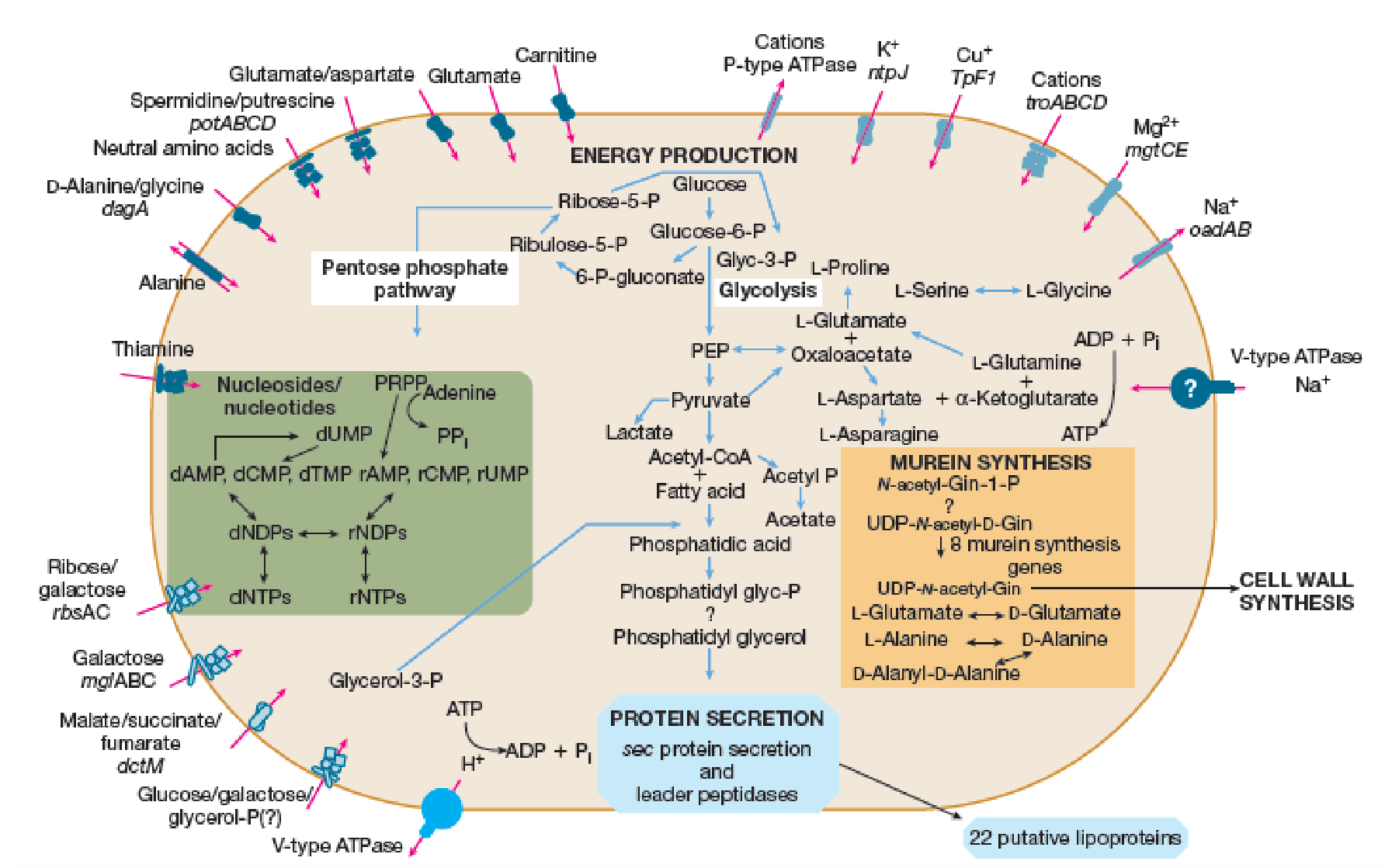
Prescott's Microbiology
11th Edition
ISBN: 9781260211887
Author: WILLEY, Sandman, Wood
Publisher: McGraw Hill
expand_more
expand_more
format_list_bulleted
Textbook Question
Chapter 18.5, Problem 1MI

Figure 18.12 Metabolic Pathways and Transport Systems of Treponema pallidum. This depicts T. pallidum
Based on this genomic reconstruction, can you determine if T. pallidum has a respiratory or fermentative metabolism?
Expert Solution & Answer
Trending nowThis is a popular solution!

Students have asked these similar questions
Standard Concentration (caffeine) mg/L
Absorbance Reading
10
0.322
20
0.697
40
1.535
60
2.520
80
3.100
Please draw in the missing answer, thank you
Please fill in all blank questions, Thank you
Chapter 18 Solutions
Prescott's Microbiology
Ch. 18.1 - MICRO INQUIRY What is the function of the 3-OH...Ch. 18.1 - MICRO INQUIRY Why is it important that identical...Ch. 18.2 - MICRO INQUIRY Which step (or steps) in this...Ch. 18.2 - Retrieve, Infer, Apply Why is the Sanger technique...Ch. 18.2 - Retrieve, Infer, Apply Explain the difference...Ch. 18.2 - Retrieve, Infer, Apply Why does reversible chain...Ch. 18.2 - Prob. 4CCCh. 18.2 - Retrieve, Infer, Apply Suggest a medical and an...Ch. 18.3 - Retrieve, Infer, Apply NGS techniques are...Ch. 18.3 - Retrieve, Infer, Apply Examine figure 18.8. How...
Ch. 18.4 - Prob. 1MICh. 18.4 - Prob. 1CCCh. 18.4 - Prob. 2CCCh. 18.4 - Prob. 3CCCh. 18.5 - Figure 18.12 Metabolic Pathways and Transport...Ch. 18.5 - Prob. 2MICh. 18.5 - Prob. 3MICh. 18.5 - Prob. 1CCCh. 18.5 - Retrieve, Infer, Apply How might the following...Ch. 18.5 - Retrieve, Infer, Apply Compare and contrast...Ch. 18.5 - Retrieve, Infer, Apply Why does two-dimensional...Ch. 18.5 - Retrieve, Infer, Apply What is the difference...Ch. 18.5 - Retrieve, Infer, Apply Describe a ChIP-Seq...Ch. 18.7 - Prob. 1MICh. 18.7 - Retrieve, Infer, Apply Cite an infectious disease...Ch. 18.7 - Prob. 2CCCh. 18.7 - Prob. 3CCCh. 18 - Prob. 1RCCh. 18 - Prob. 2RCCh. 18 - Prob. 3RCCh. 18 - Prob. 4RCCh. 18 - Prob. 5RCCh. 18 - Prob. 1ALCh. 18 - Prob. 2ALCh. 18 - You are developing a new vaccine for a pathogen....Ch. 18 - Prob. 4AL
Knowledge Booster
Learn more about
Need a deep-dive on the concept behind this application? Look no further. Learn more about this topic, biology and related others by exploring similar questions and additional content below.Similar questions
- please fill in missing parts , thank youarrow_forwardplease draw in the answers, thank youarrow_forwarda. On this first grid, assume that the DNA and RNA templates are read left to right. DNA DNA mRNA codon tRNA anticodon polypeptide _strand strand C с A T G A U G C A TRP b. Now do this AGAIN assuming that the DNA and RNA templates are read right to left. DNA DNA strand strand C mRNA codon tRNA anticodon polypeptide 0 A T G A U G с A TRParrow_forward
- Please identify the curve shown below. What does this curve represent? Please identify A, B, C, D, and E (the orange oval). What is occurring in these regions?arrow_forwardPlease identify the test shown here. 1) What is the test? 2) What does the test indicate? How is it performed? What is CX? 3) Why might the test be performed in a clinical setting? GEN CZ CX CPZ PTZ CACarrow_forwardDetermine how much ATP would a cell produce when using fermentation of a 50 mM glucose solution?arrow_forward
- Determine how much ATP would a cell produce when using aerobic respiration of a 7 mM glucose solution?arrow_forwardDetermine how much ATP would a cell produce when using aerobic respiration to degrade one small protein molecule into 12 molecules of malic acid, how many ATP would that cell make? Malic acid is an intermediate in the Krebs cycle. Assume there is no other carbon source and no acetyl-CoA.arrow_forwardIdentify each of the major endocrine glandsarrow_forward
arrow_back_ios
SEE MORE QUESTIONS
arrow_forward_ios
Recommended textbooks for you
 BiochemistryBiochemistryISBN:9781305577206Author:Reginald H. Garrett, Charles M. GrishamPublisher:Cengage Learning
BiochemistryBiochemistryISBN:9781305577206Author:Reginald H. Garrett, Charles M. GrishamPublisher:Cengage Learning Biology Today and Tomorrow without Physiology (Mi...BiologyISBN:9781305117396Author:Cecie Starr, Christine Evers, Lisa StarrPublisher:Cengage Learning
Biology Today and Tomorrow without Physiology (Mi...BiologyISBN:9781305117396Author:Cecie Starr, Christine Evers, Lisa StarrPublisher:Cengage Learning Biology: The Dynamic Science (MindTap Course List)BiologyISBN:9781305389892Author:Peter J. Russell, Paul E. Hertz, Beverly McMillanPublisher:Cengage Learning
Biology: The Dynamic Science (MindTap Course List)BiologyISBN:9781305389892Author:Peter J. Russell, Paul E. Hertz, Beverly McMillanPublisher:Cengage Learning Human Heredity: Principles and Issues (MindTap Co...BiologyISBN:9781305251052Author:Michael CummingsPublisher:Cengage Learning
Human Heredity: Principles and Issues (MindTap Co...BiologyISBN:9781305251052Author:Michael CummingsPublisher:Cengage Learning Human Physiology: From Cells to Systems (MindTap ...BiologyISBN:9781285866932Author:Lauralee SherwoodPublisher:Cengage Learning
Human Physiology: From Cells to Systems (MindTap ...BiologyISBN:9781285866932Author:Lauralee SherwoodPublisher:Cengage Learning


Biochemistry
Biochemistry
ISBN:9781305577206
Author:Reginald H. Garrett, Charles M. Grisham
Publisher:Cengage Learning

Biology Today and Tomorrow without Physiology (Mi...
Biology
ISBN:9781305117396
Author:Cecie Starr, Christine Evers, Lisa Starr
Publisher:Cengage Learning

Biology: The Dynamic Science (MindTap Course List)
Biology
ISBN:9781305389892
Author:Peter J. Russell, Paul E. Hertz, Beverly McMillan
Publisher:Cengage Learning

Human Heredity: Principles and Issues (MindTap Co...
Biology
ISBN:9781305251052
Author:Michael Cummings
Publisher:Cengage Learning

Human Physiology: From Cells to Systems (MindTap ...
Biology
ISBN:9781285866932
Author:Lauralee Sherwood
Publisher:Cengage Learning
Parasites: Protozoa (classification, structure, life cycle); Author: ATP;https://www.youtube.com/watch?v=V4iSB0_7opM;License: Standard youtube license